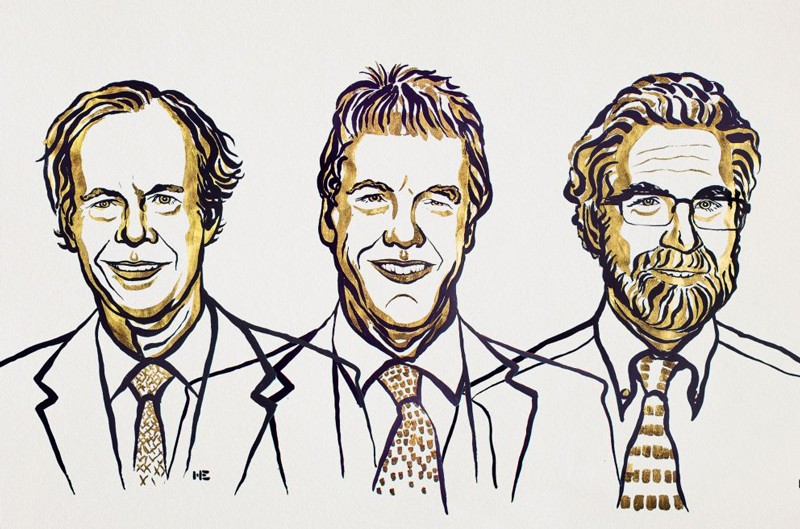 |
| William Kaelin, Peter Ratcliffe and Gregg Semenza have together worked out how genes respond when oxygen is depleted.Credit: Ill. Niklas Elmedhed/Nobel Media |
Three
scientists - cancer researcher William Kaelin at the Dana-Farber Cancer
Institute in Boston, Massachusetts; physician-scientist Peter Ratcliffe at the
University of Oxford, UK, and the Francis Crick Institute in London; and
geneticist Gregg Semenza at Johns Hopkins University in Baltimore,
Maryland have
won the 2019 Nobel Prize in Physiology or Medicine for describing how cells sense and respond to oxygen by switching genes on and off.
This
discovery has been key in understanding human diseases such as cancer and
anaemia. Among
the applications of their discovery is a better understanding of how the body
reacts when oxygen levels drop owing to exercise or stroke, and efforts to
manipulate the response to slow the growth of oxygen-hungry cancer tumours.
Their work has
helped researchers to understand how the body adapts to low oxygen levels by,
for example, cranking out red blood cells and growing new blood vessels.
“This is a
fundamental discovery that they’ve contributed to” says Celeste Simon, a
cancer biologist at the University of Pennsylvania in Philadelphia. “All
organisms need oxygen, so it’s really important.
“The field really
coalesced around this discovery, which was dependent on each one of their
findings,” says Randall Johnson, a physiologist at the University of Cambridge,
UK, and the Karolinska Institute in Stockholm, and a member of the Nobel
Assembly. “This really was a three-legged stool.”
In work conducted
in the 1990s, the scientists discovered the molecular processes that cells go
through to respond to oxygen levels in the body. They found that central to
this is a mechanism involving proteins called HIF and VHL.
Meanwhile, Kaelin
showed that a gene called VHL also seemed to be involved in how cells respond
to oxygen, through studying a genetic syndrome called von Hippel-Lindau’s
disease; families with the disease carry mutations in VHL and the condition
raises the risk of certain cancers. Semenza and Ratcliffe studied the
regulation of a hormone called erythropoietin (EPO), which is crucial for
stimulating the production of red blood cells in response to low levels of
oxygen. Semenza and his team identified a pair of genes that encode the two
proteins that form a protein complex called hypoxia-inducible factor (HIF),
which work together to turn on certain genes and boost erythropoietin
production when oxygen is low.
Ratcliffe and his
team later found that the protein expressed by the VHL gene interacts with one
of the components of HIF, turning off responses to low-oxygen conditions by
marking the HIF component for destruction once oxygen levels rise.
And in 2001,
teams led by Kaelin and Ratcliffe both showed that, as part of this process, a
chemical modification to the VHL protein, called prolyl hydroxylation, allows
cells to respond to oxygen levels incredibly rapidly. When oxygen is present,
the modified form of VHL can bind to HIF, which leads to its breakdown. But this
modification is blocked when cells are oxygen-starved, kick-starting the
activity of HIF.
As a result,
cells can react to low oxygen levels by simply blocking the breakdown of HIF,
notes Mark Dewhirst, a cancer biologist at Duke University in Durham, North
Carolina. “The cell can respond in minutes.”
The work has led
researchers to develop drugs that target oxygen-sensing processes, including
for cancer. Drugs that prevent VHL from binding to HIF and causing its
degradation, called prolyl hydroxylase inhibitors, are also being investigated
as treatments for anaemia and renal failure. Chinese regulators approved the
first of these drugs in 2018.



